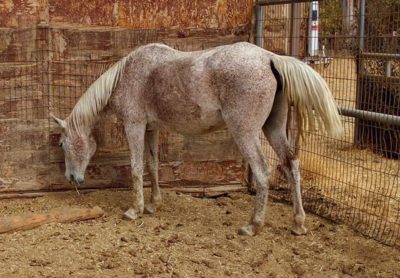Probable Origin of the Hadban strain of the Jarba — Shammar
From the Abbas Pasha Manuscript — that bottomless treasure — page 546:
“and we mated her a second time to the Hadban horse of Saffuq al Jarba, and he is of the horses of al Jaless of al Kawakibah”
Elsewhere in the Manuscript it is recorded that the stud/marbat of Hadban Enzahi of the al-Kawakibah section of the Ruwalah belonged to Nahi al-Mushayteeb of al-Kawakibah, and that it was an old stud. Al-Mushayteeb obtained them from al-Nazahi of the ancient Bedouin tribe of al-Fudul.
That Hadban stallion in the testimony was the great-grandfather of a horse that was three years old in the early 1850s. This means that in the 1830s or early 1840s at the very least, there was already a branch of the Hadban strain of the Kawakibah with the Jarba leaders of the Shammar, and that one of the horses of this Shammar branch of that Hadban strain was used as a stallion. Saffuq al-Jarba, nicknamed “al-muhazzam”, meaning “Saffuq of the belt” because he was so warlike that he reportedly never left his military gear, died in 1843.
This is very consistent with the testimony of the Jarba leaders of the Shammar in the mid 1980s about their prized Hadban strain having been with them for more than one hundred years according to one testimony (that of Hameedi al-Daham al-Hadi al-Jarba), and for some two hundred years, according to another (that of his brother Ahmad). It does not constitute rock-solid proof that the Hadban Enzahi of the Jarba came from the Mushayteeb stud of the Ruwalah, but the likelihood is high.
Whatever the case, I am very proud to own a representative of the Hadban Enzahi strain of the Jarba Shammar: RL Zahra Assahra (Portent x Antezzah by Grand Pass), a 1995 Hadba Enzahi tracing to *Hadba, the mare of ‘Ajil ibn Zaydan al-Jarba of the Shammar, and purchased by Homer Davenport in 1906.

Edouard: Thank you for that information. This kind of thing is why this website is such a valuable resource. I need to update my library and get copies of the Abbas Pasha manuscript. Don’t some of the Egyptian breeder groups have modern day copies of it for sale?
best wishes
Bruce Peek
it’s out of print and terribly expensive
shoot!
As we know from Dr.Bowling’s study about the MtDNA of the damlines, Venus,
the Hadbah Enzahiyah mare of Khedive Abbas II
shares the same haplotype with Rodania and Roga El Beda. (… and also with the Davenport mares Urfah and Wadduda.)
Hadba (1900) has another one.
We have two different Hadban damlines?
Both Venus and Davenport’s Hadbah(1900) are Hadbah?…or which one is the real Hadbah?
Is the above manuscript been scaned in someone’s library for e-book type reading? probably or maybe a huge project?
The mtDNA study is an attempt to describe the existing population structure; I can’t see that it’s our place to re-write the history of the horses, what we need to do is re-interpret it in the light of what the biology shows us.
The results seem to be saying that at least in some cases a strain could be founded on a group of mares, rather than descending from a single individual as the tradition tells it. This is not surprising if you consider strains originated as “the mares of” a family or clan; there must have been a point before pedigrees were known, when they were simply “our mares.”
I won’t take the time to check all the lines that match Rodania, but it’s a lot more than those listed here, amounting to a substantial proportion of all recorded families. Charles Craver has called that the family of “the mare of Baz” (Noah’s son credited with capturing and taming the first wild mare).
I beg Baz’s pardon, he was Noah’s grandson.
Also meant to say Zahra spent a couple of weeks here between legs of her trip, and she’s a very solid mare and a sweetheart.
Michael, do you know the primary source for that legend of the mare of Baz? I could never find the source.
and that photos is yours Michael, with thanks!
Interesting point Michael.
I’ll look when I get home, Edouard. I suspect I first read it in The Authentic Arabian.
Baz was the son of Omam, who was the son of Lud, who was the son of Sem, who was the son of Noah. Baz lived about 3000-3200 years ago B.C.
Hisham Ibn Mohammed Al Kelbi ( who lived in Valencia at the time of Haroun Al Rashid ) tells about the story in his work.Probably this is the primary source of this theory, isn’t it?
There is certainly an interesting story.
It would be nice if someone speak arabic, could tell us…
There you go. LAB got it from Ibn al-Kalbi’s book of the horse.
http://daughterofthewind.org/book-ibn-al-kalbis-book-of-the-horse-ca-800-ad/
You get great pleasure.
At the time, I did not see this post.
Thank you.
While doing a Google lens on my Arab mare, a photo come up from your site of an Arab mare that is 100% identical! I wish there were other ankles of this mare but holy cow. I can’t believe the resemblance. My mare is about 21 years of age and was a lesson horse for the past 10 years before I had her and I’m not sure where she came from before that. I’m sure curious if she is related to this horse but she never came with any paperwork
I want to send you a photo but I don’t see a way to contact you 🙁
ealdahdah@hotmail.com 🙂